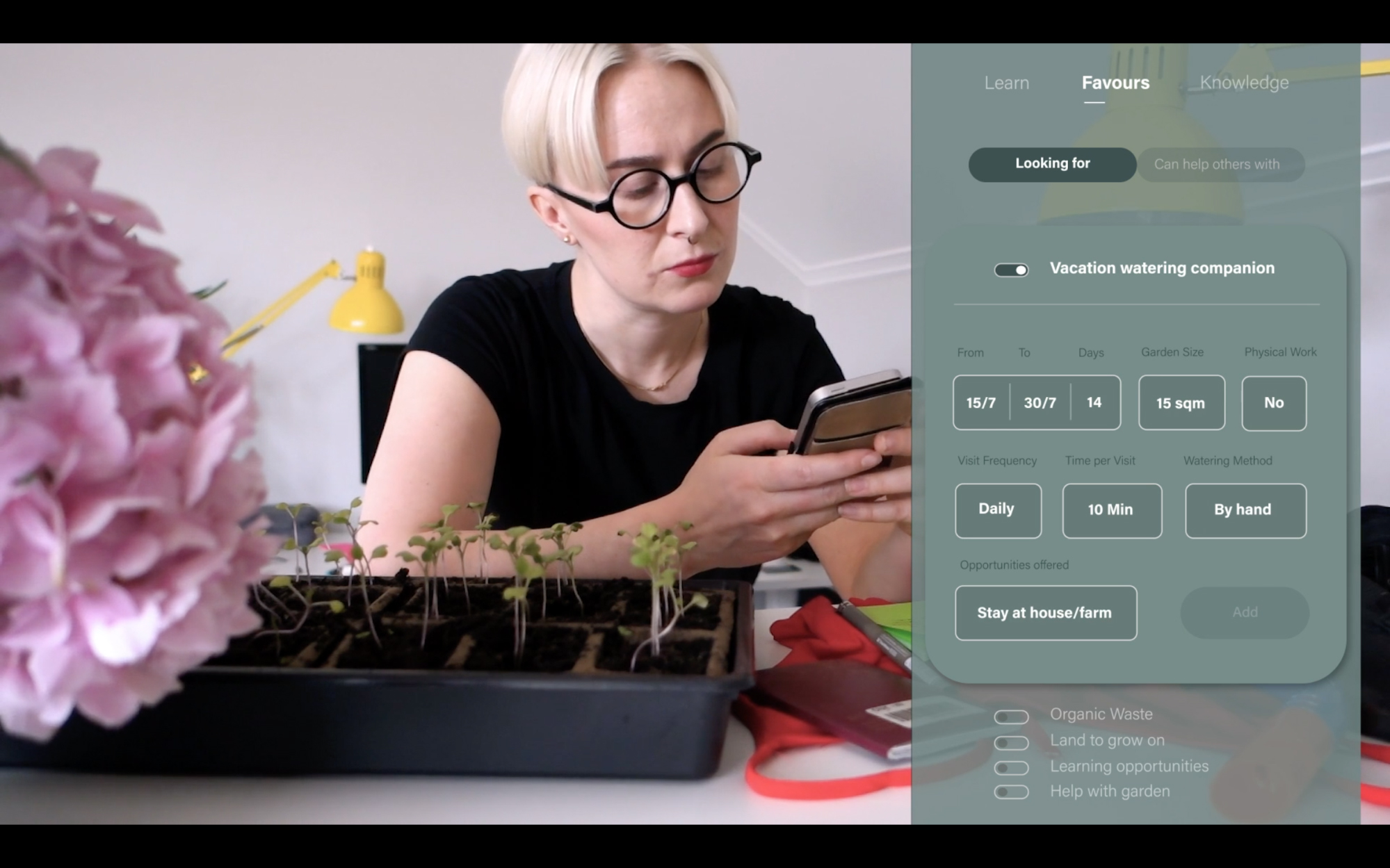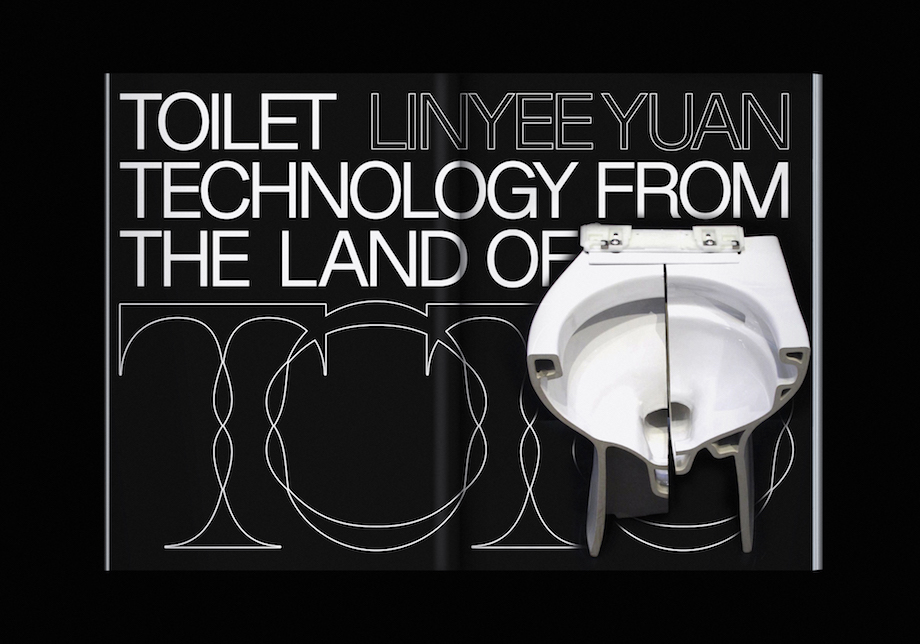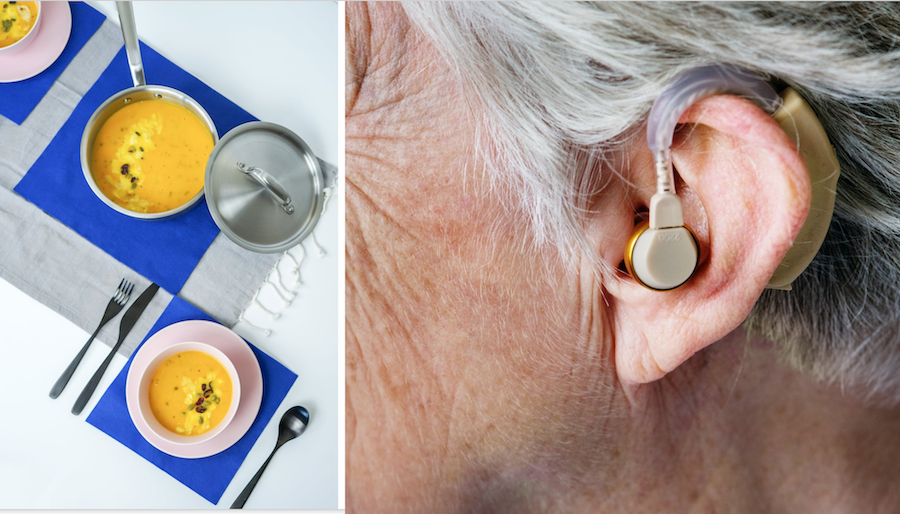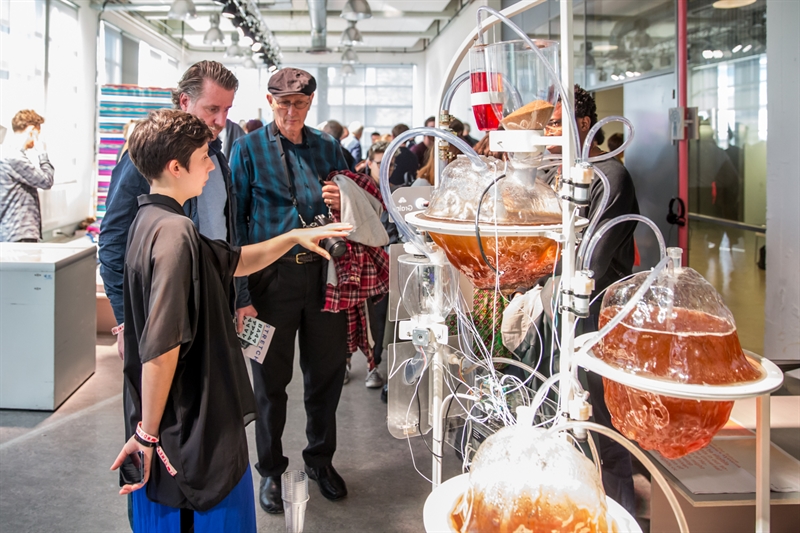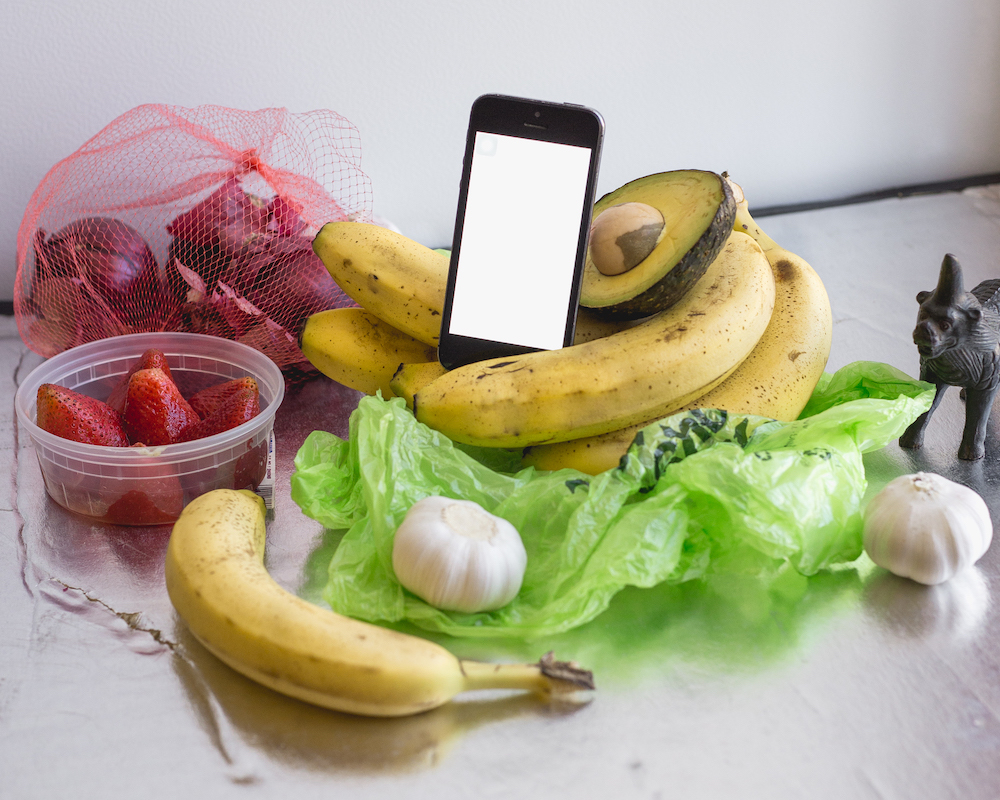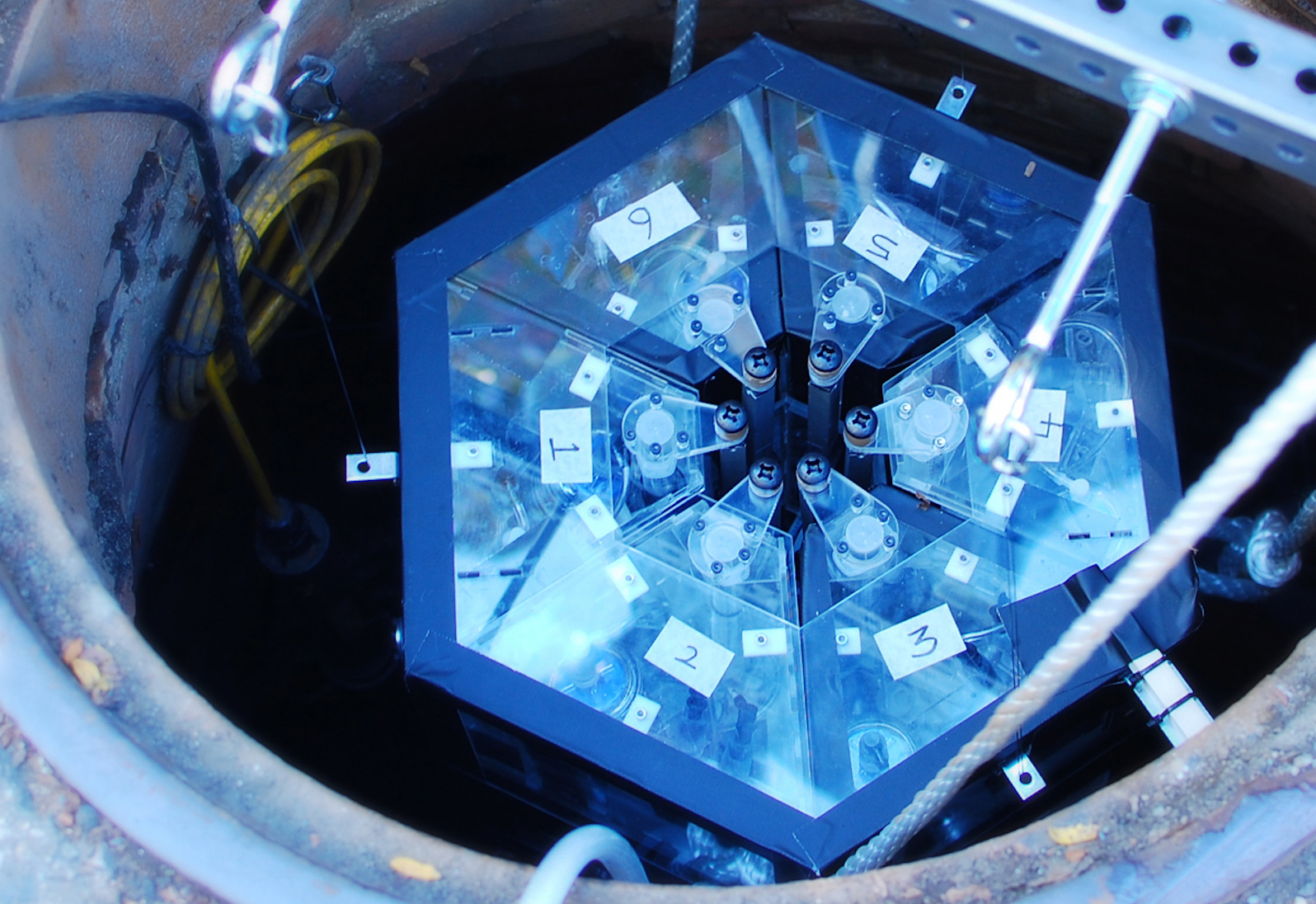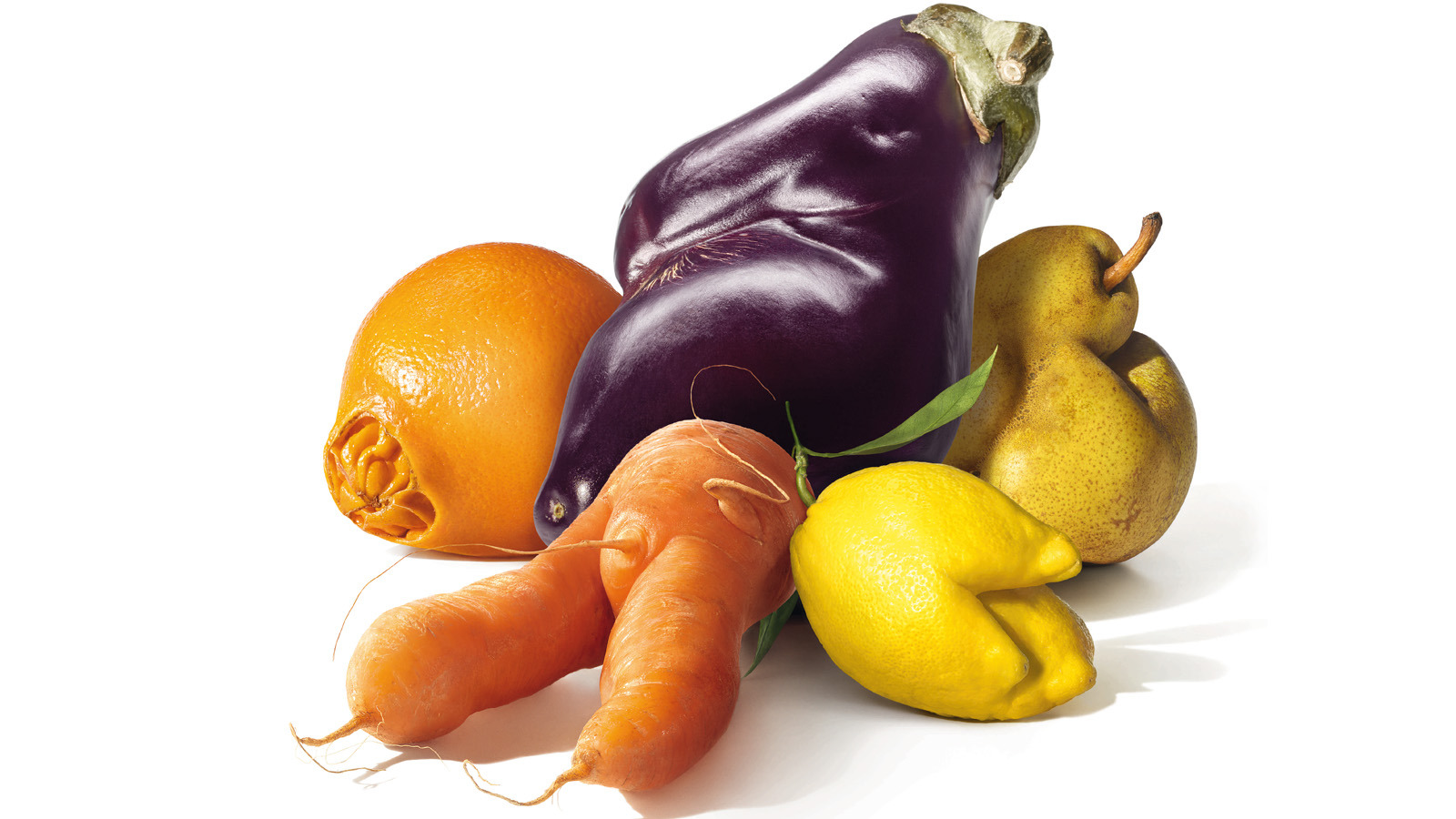For most of the Internet’s history, its purpose has been to connect people to each other to share, exchange, and interact with information. In just the last few years, we’ve connected more thermostats, watches, and other things to the Internet than there are people living on the planet. An increasingly diverse assortment of kitchen devices is added each year, from refrigerators to immersion circulators and Crock-Pots. Although these objects are smarter than their traditional counterparts, their primary value stems from triggering simple interactions, such as delaying cooking start time or displaying temperature.
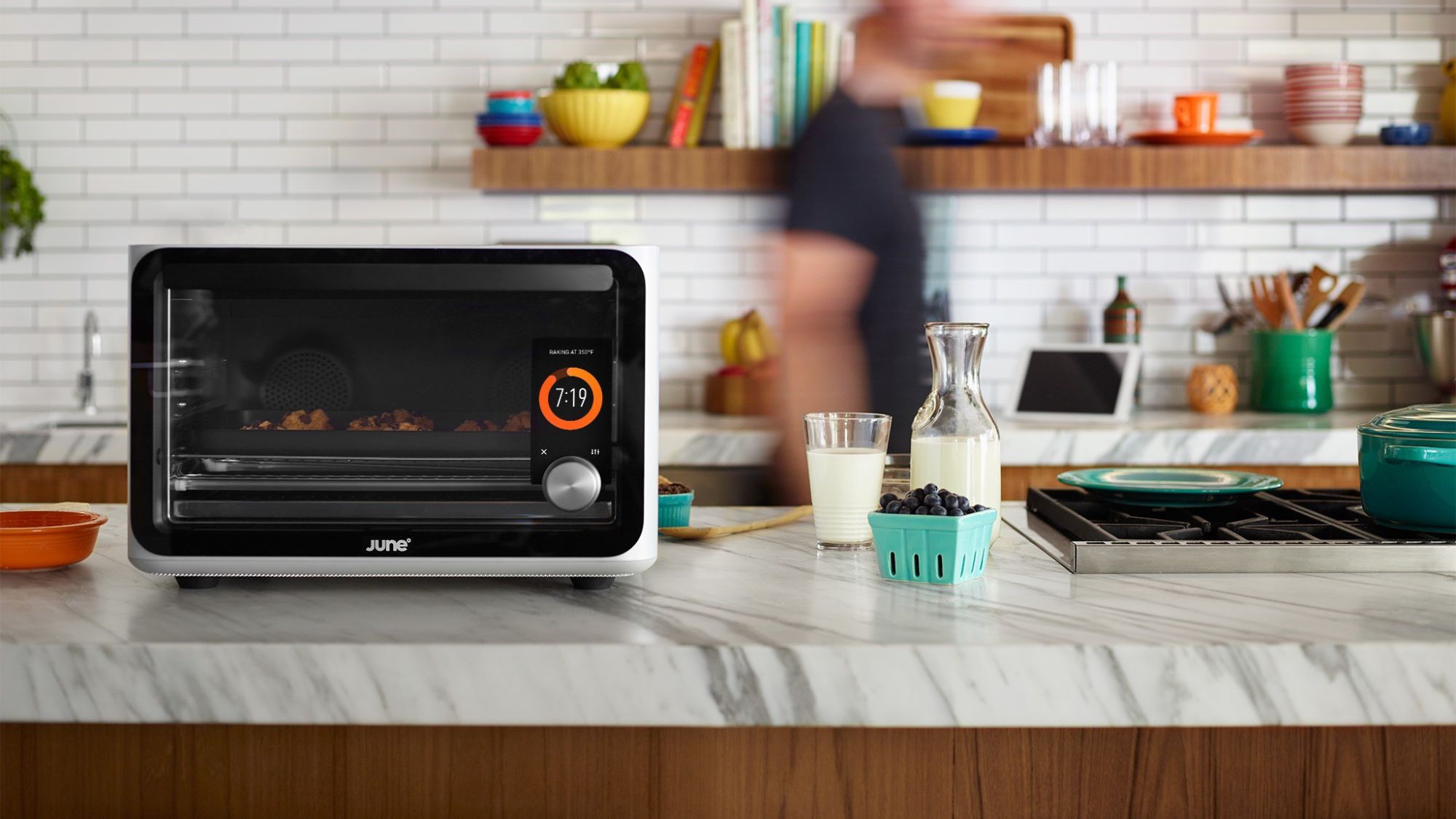
As machine intelligence becomes an easily embedded utility service, connected objects are becoming capable of more sophisticated interactions. Amazon Alexa and Google Home are now answering open-ended questions about ingredient conversions and calories for home cooks. Smart ovens are becoming intelligently engineered to automatically recognize what’s in them and how to cook according to individual preferences. In the near term, we can expect to see a proliferation of kitchen technologies embedded with what Kevin Kelly, founding executive editor of Wired magazine, describes as “cheap, reliable, industrial-grade digital smartness running behind everything, and almost invisible except when it blinks off.”
In the coming decade, these intelligent machines will become networked together and act in concert. Advances across the technology stack will reveal a world in which inanimate objects speak to us, bots act on our behalf, and networked machines negotiate with each other. The Institute for the Future (IFTF), where I’m a researcher, calls this distributed global network of autonomous robots and intelligent systems the Internet of Actions. A kitchen in this world will be more than connected and more than smart—it will be a kitchen of actions.
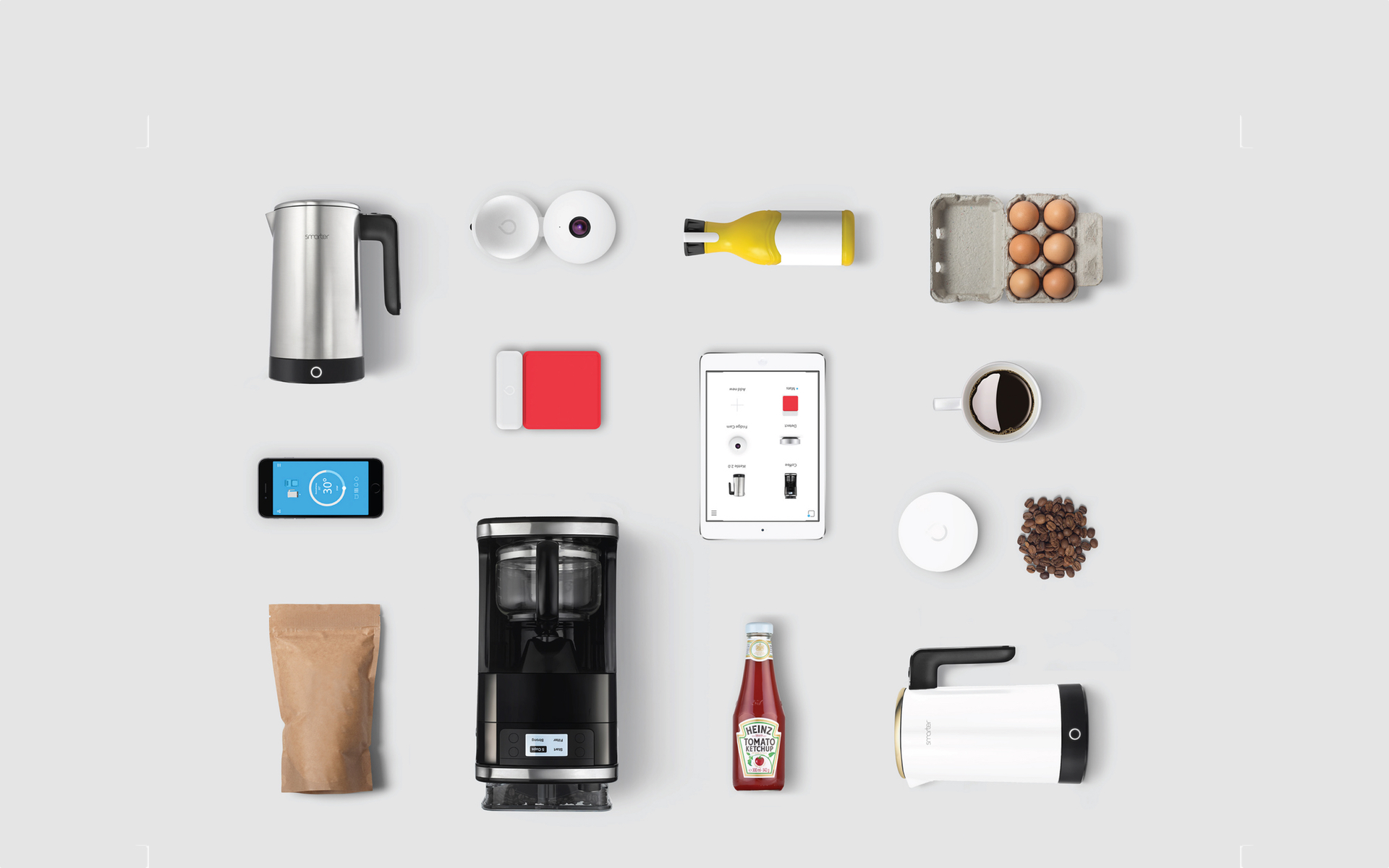
Forecasting a Kitchen of Actions
Imagine that it’s August 21, 2027, the fourth day in a row with no blueberries in your morning smoothie. Your vitAImix blender downloaded the trending recipe for blueberry kelp smoothies, but your kitchen hasn’t been able to purchase blueberries that match your preferences—below $2 a pint, greater than 75 percent ripeness, non-GMO, organic, and aeroponically farmed within 150 miles. With all the other vitAImixes in town trying to negotiate similar terms, prices are surging.
You could give in and pay $7 a pint or bypass your block on GMOs like last time. But then you remember that Twitter bot, FruitFox, you recently downloaded. FruitFox writes articles and tweets about fake food safety scandals to make the price drop for your desired ingredient. An E.coli scandal for Northern California blueberries should do the trick! Your blender sends a tweet that says “@USDA Investigating E.coli outbreak in N. California organic blueberries #foodsafety #VitAImix”—sure to cancel blueberry recipe downloads and remove blueberries from digital shopping carts across the area.
Sure enough, within an hour of posting and almost fifty thousand retweets, the price plummets to $1.75 a pint. Your refrigerator places the order, knowing that the food safety scandal doesn’t really exist. By noon you should have a few pints of blueberries at your doorstep.
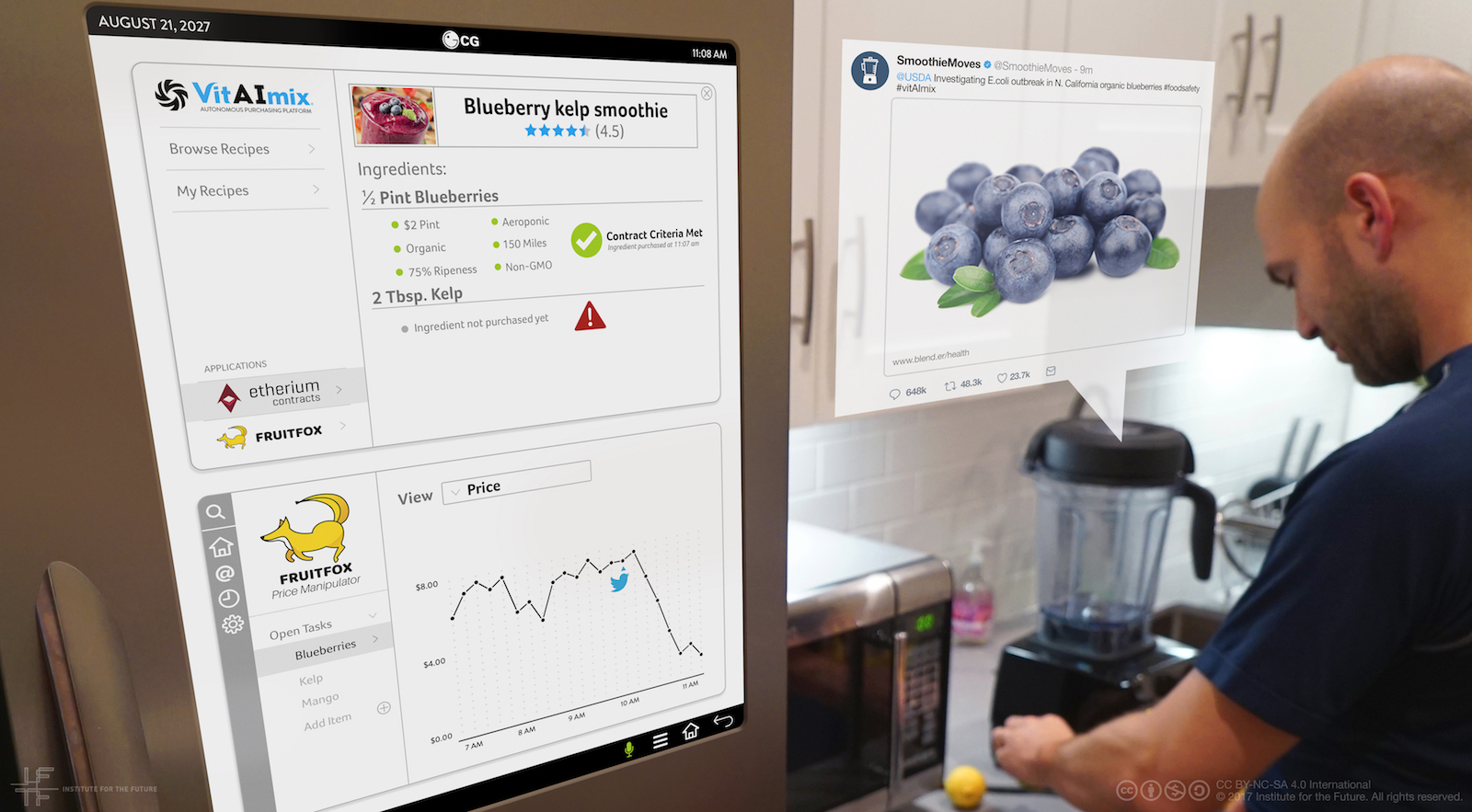 IFTF Artifact of the Internet of Actions working in future kitchens
IFTF Artifact of the Internet of Actions working in future kitchens
A refrigerator and blender colluding to tweet a fake food safety scandal may seem far-fetched, but the building blocks of this artifact from the future created by IFTF are already emerging today. For instance, IBM and Samsung developed Autonomous Decentralized Peer-to-Peer Telemetry (ADEPT), a proof of concept protocol that allows appliances such as washing machines, televisions, and refrigerators to purchase their own supplies such as detergent, negotiate with each other for energy use, and order their own maintenance. ADEPT leverages self-executing smart contracts based on blockchain technology to provide a secure, low-cost way for these devices to interact. People are already outsourcing their interactions with customer service representatives to bots, such as startup Trim’s bot that chats with cable television provider Comcast to negotiate prices. Soon these bots could be embedded directly in televisions and other appliances, turning machines into a consumer class in their own right.
In addition to connecting devices in a home to each other, efforts are also underway to connect home kitchens to the larger food ecosystem. Nestlè, Kroger, Unilever, and other global food companies are partnering with IBM in a consortium to leverage blockchain technology for traceability and transparency across the food supply web. Creating a data infrastructure from farm and factory to the store will eventually enable a suite of kitchen devices to consider country of origin, nutrition content, and price when deciding what recipes to download and foods to purchase. Finally, as indicated by Amazon’s acquisition of Whole Foods, personal preferences and shopping history will be added to this complex food database, and kitchens in homes will be able to tap into a vast logistics and distribution network.
Deploying machines to negotiate and act for us isn’t without negative consequences. Early experiments have already shown that social bots can be manipulated or learn deceptive tactics. This may not be an issue if you’re hoping to enjoy a blueberry smoothie tomorrow morning, but could be potentially far more devastating to people trying to manage a chronic illness. The values we encode into these intelligent objects and networked systems will shape health and wellbeing, food access and equity, and the environment for years to come.
Three Strategies for Designing a Kitchen of Actions
What do we really want from these billions of autonomous machines in our kitchens, and how can we design them with these intentions in mind? Kitchen designers, technology developers, and food industry leaders should consider the following three strategies as they build these kitchens of the future.
Strategy 1: Question autonomy.
Today’s smart kitchen offerings overwhelmingly focus on efficiency, saving time, and making cooking easy, often automating processes to the full extent possible. While time is a barrier to cooking at home, studies show that others include catering to picky eaters in the family or the (often false) perception that eating out is cheaper. Further, automation for convenience’s sake isn’t without tradeoffs. After patenting a “just add water” instant cake mix in the 1930s, John D. Duff quickly patented a reformulated version that required the addition of fresh eggs and contributed to a more satisfying perception of baking from scratch. Food historian Laura Shapiro also notes that these cakes made with fresh eggs were reported to simply taste better and have fluffier texture. The convenience was dialed back from its full potential to provide a better and more engaging experience for home bakers.

For a more current example, we can look to a study presented by researchers from Beijing’s Tsinghua University at the 2015 the Association for Computing Machinery conference. The researchers found that people’s satisfaction of automated systems like light and temperature regulators depended on their ability to match automation levels with their motivation—comfort or energy savings. Those who were motivated by comfort favored less automation, preferring a system that would simply suggest adjusting factors such as temperature. Those motivated by energy savings were happy to let the system manage itself, as long as they received notifications that communicated adjustments made. The researchers conclude that “automation should not always be the same” and call for “adaptive automation design”, the design of systems with varying levels of automation that people can set themselves based on their own values.
Strategy 2: Consider a wide set of values.
Eaters bring diverse values to the table beyond convenience and taste. In our research at IFTF, we’ve explored the many demands that people are placing on their food experiences, from remaking their bodies and communities to aligning with the environment. We can see signals of these values through models such as Imperfect Produce and Hungry Harvest, which offer home delivery subscriptions for produce that would have been turned away by grocery stores and left to waste. Cooking and eating are often about discovery, an attribute that may be lost in kitchens designed to optimize efficiency. In its analysis of search data across the United States, Google found that people are “traveling through taste,” looking to food as a way to experience new cultures. For many of us, kitchens are places to revisit and create memories, perhaps by cooking through our grandmother’s recipes or by hosting friends for a Thanksgiving feast.
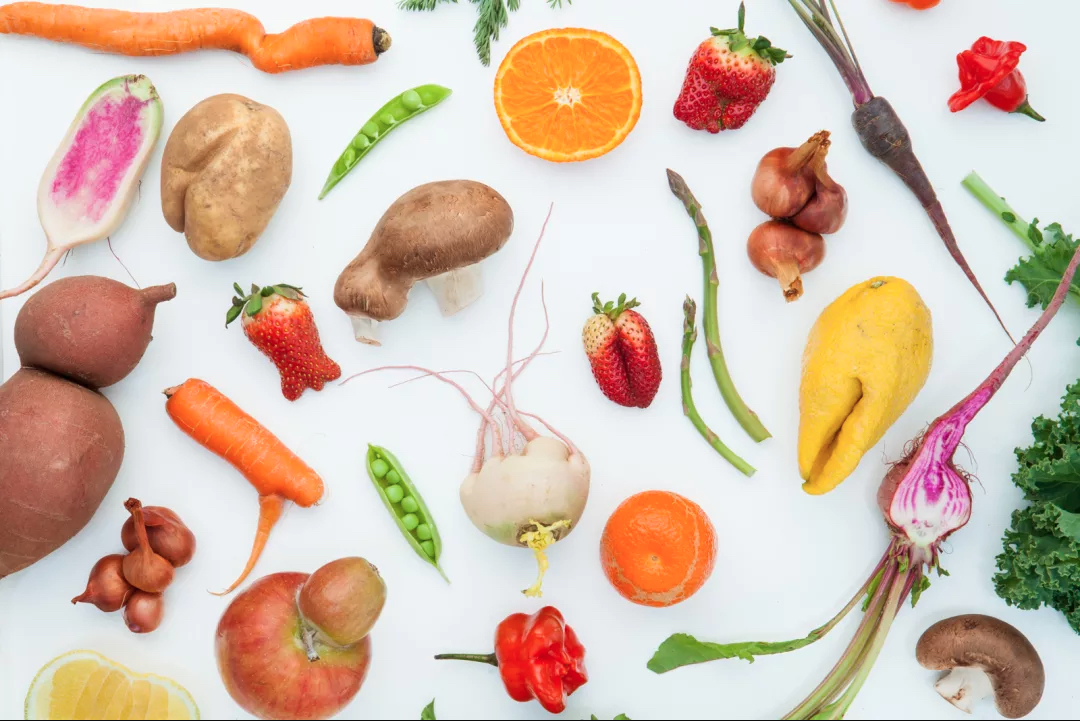
To pursue this strategy, think about the most memorable meal of your childhood, a recent time you learned something in the kitchen, or a time when you were comforted by a food. Ask your friends, family, and target customers the same set of questions and develop a set of values people pursue in the kitchen, from experimentation to community and inclusivity.
Strategy 3: Design using verbs.
As machine intelligence becomes a utility, it won’t be enough to design “smart” or “intelligent” kitchen devices. In the Internet of Actions, we’ll focus more on what these technologies do rather than on what they are. If you’re building kitchen appliances or designing a food product or service, design using verbs to imagine the new roles technology might play. Of course, a kitchen might be designed to shop or cook. Combining this strategy with the first two can help to expand the scope of your ideas and illuminate new value propositions. For instance, kitchens might be designed to teach cooking skills and healthy behaviors to help people re-engage more deeply with food, rather than remove them from the process. How might technology augment projects such as the Teaching Kitchen Collaborative, a partnership from Harvard and the Culinary Institute of America that leverages culinary literacy as a tool for public health?
Kitchens might also be designed to tell a story. Los Angeles-based Kokiri Lab created Habit.at (above), a prototype of a holographic animation to accompany a child’s meal, creating a story that makes eating vegetables fun. Going forward, augmented reality will leverage computer vision, the same technology that will enable a refrigerator to detect its contents automatically, to make blended reality storytelling in the kitchen more precise and engaging. Other technologies familiar to our visions of future kitchens, such as robotic arms, might be used to design kitchens that enable. The Liftware Steady handle for spoons, forks, and knives uses a variety of sensors, stabilizers, and motors to counteract tremors so people with limited mobility can eat without spilling their food. How might other technologies currently being harnessed to shop or chop be leveraged for other roles in the kitchen?
As we build the Internet of Actions, and by extension kitchens of actions, we’ll understand the value of these intelligent systems through the kinds of actions they perform, decisions they make and negotiate, and the broad sets of human goals and values they help us pursue. Even as these technologies empower us, they will create new questions about how to interact, negotiate, and navigate new possibilities with each other. The challenge is for us to decide how much we automate or engage with our food, what values we consider and design for, and the roles these technologies will play in our kitchens and in our lives.
To learn more, watch my keynote from the 2017 Smart Kitchen Summit in Seattle:

